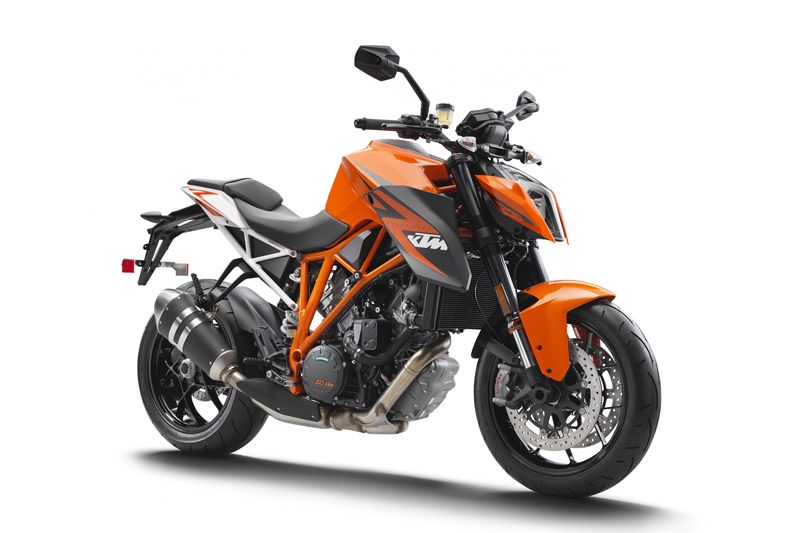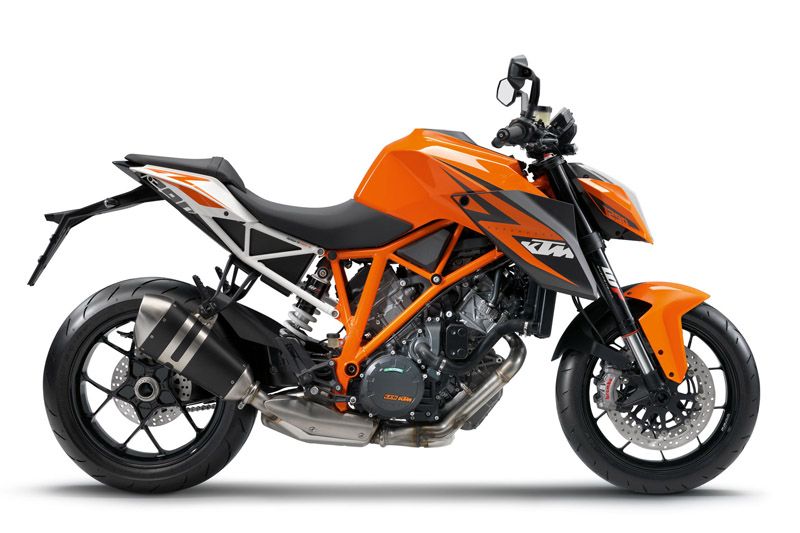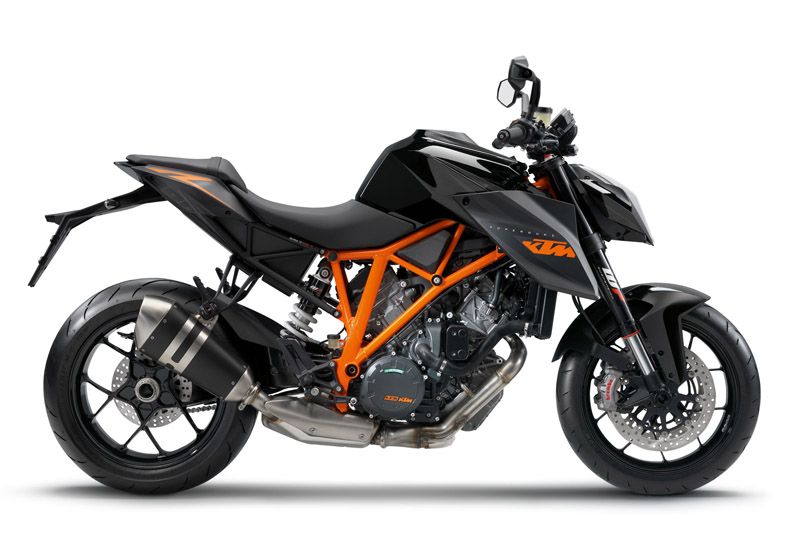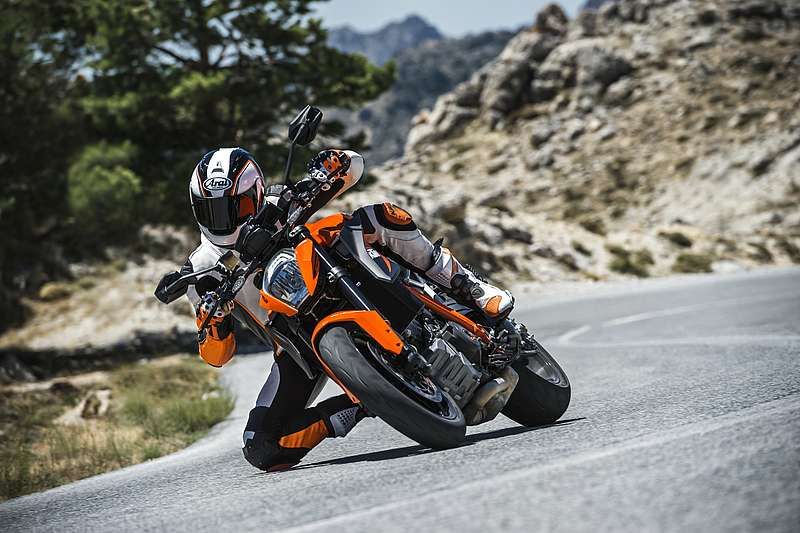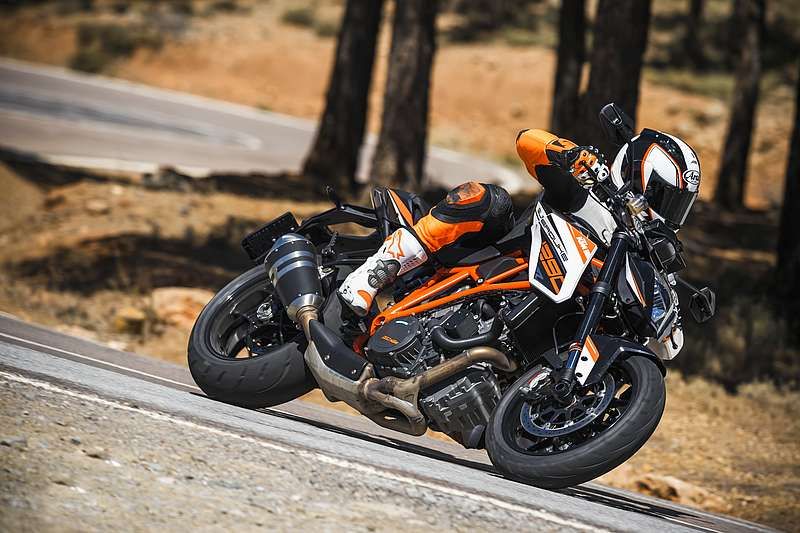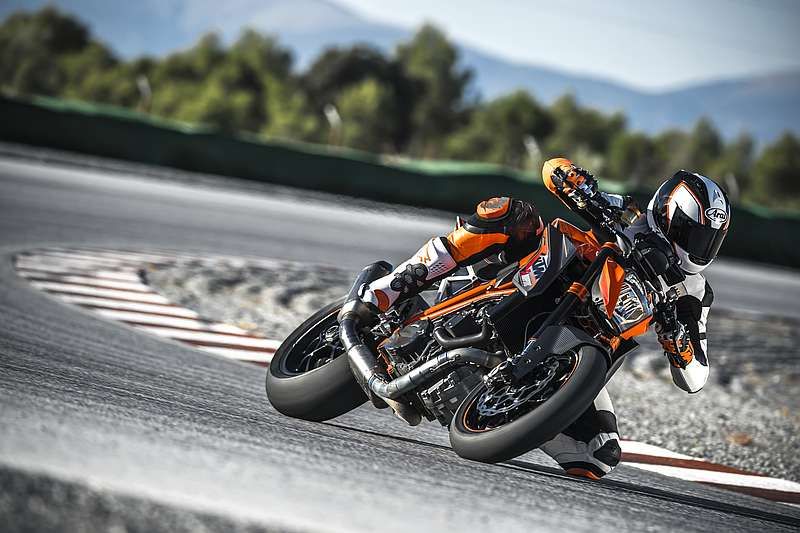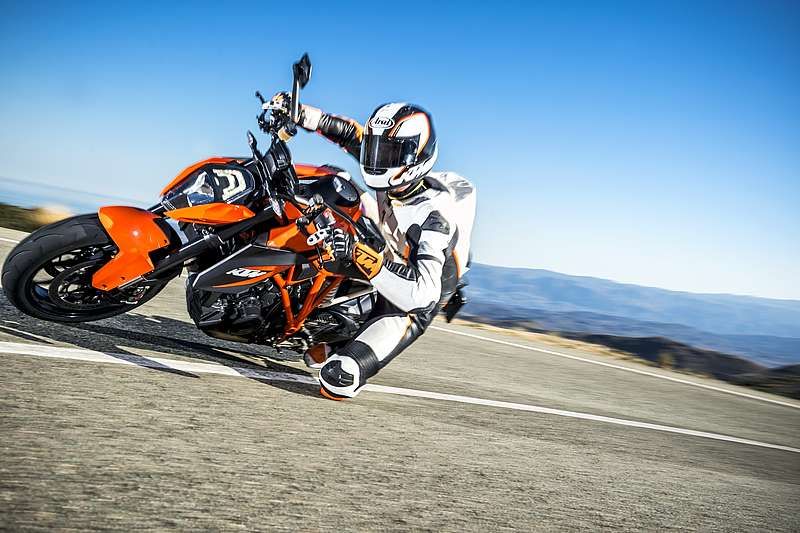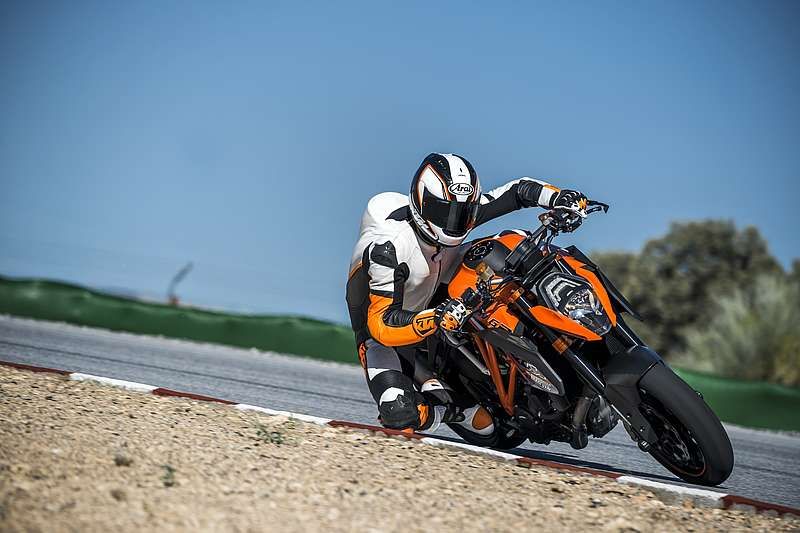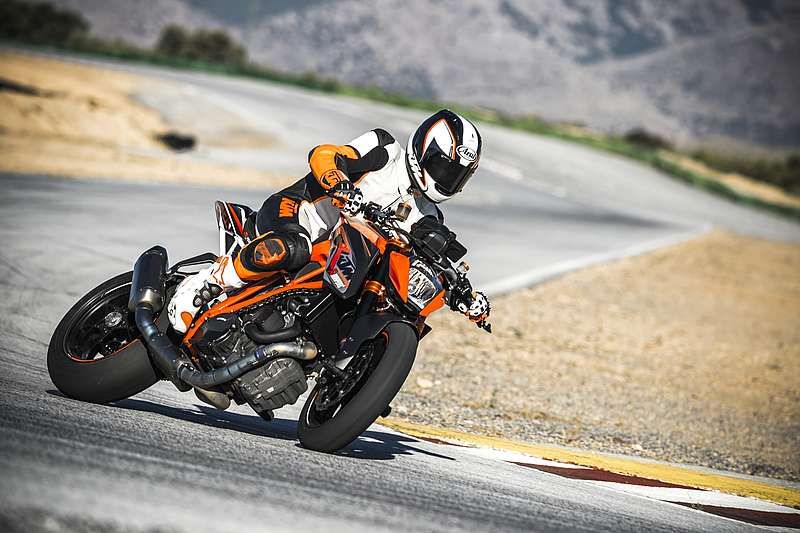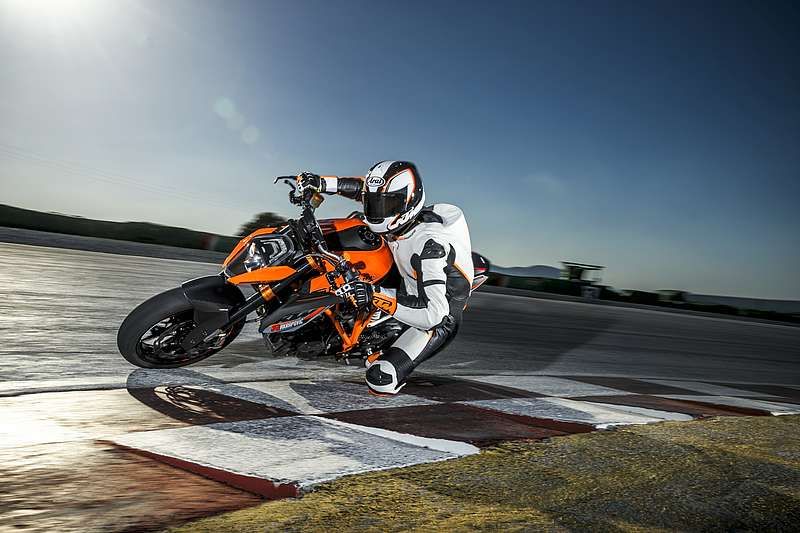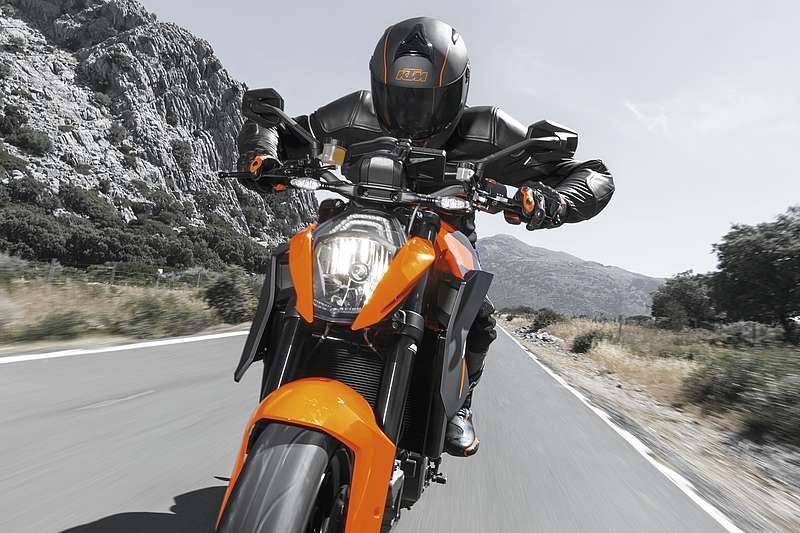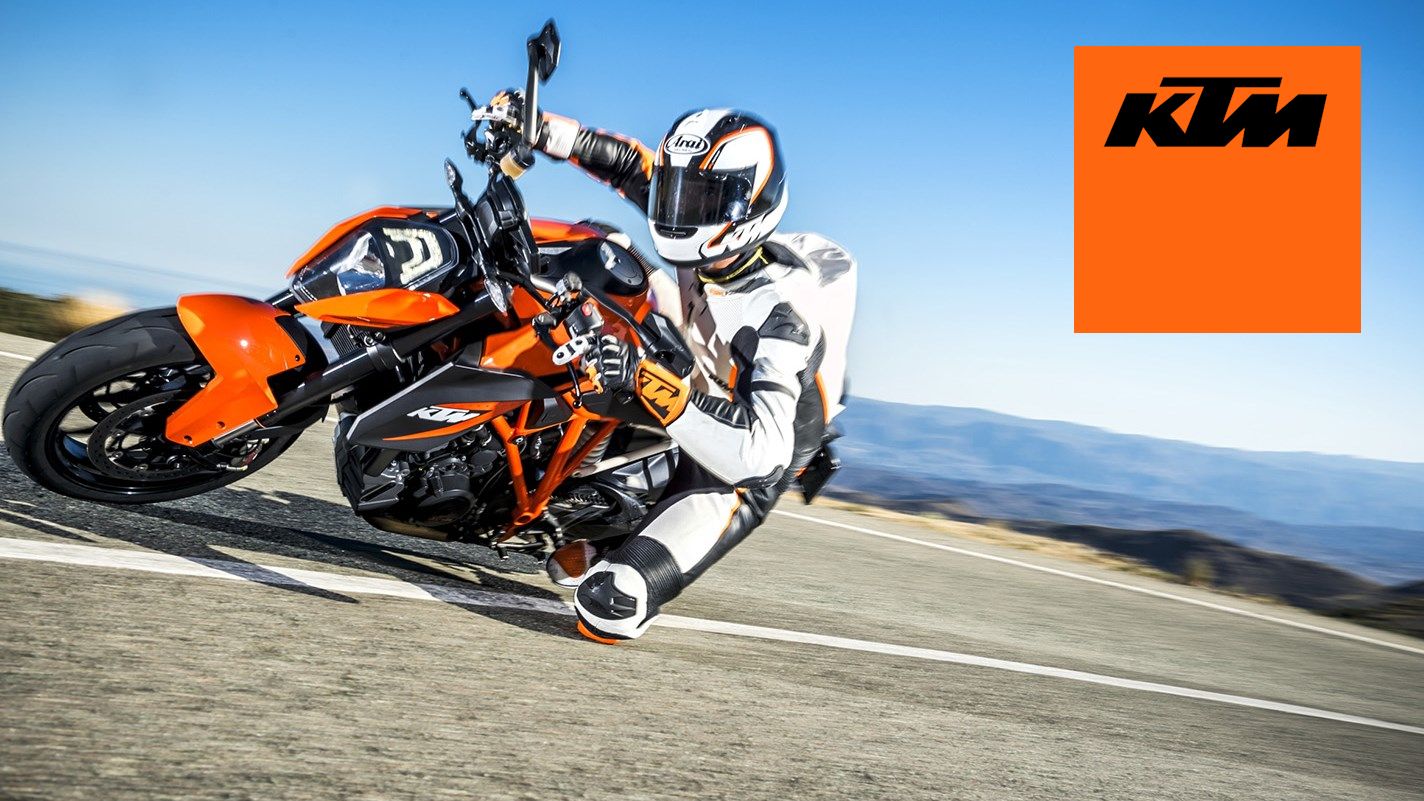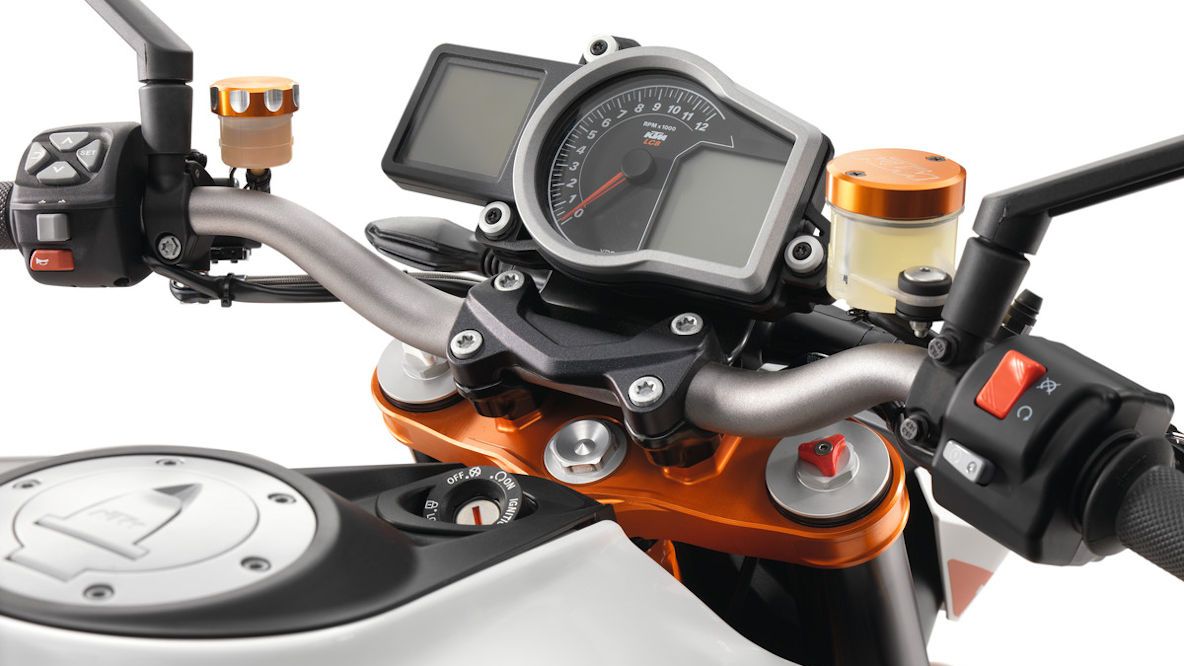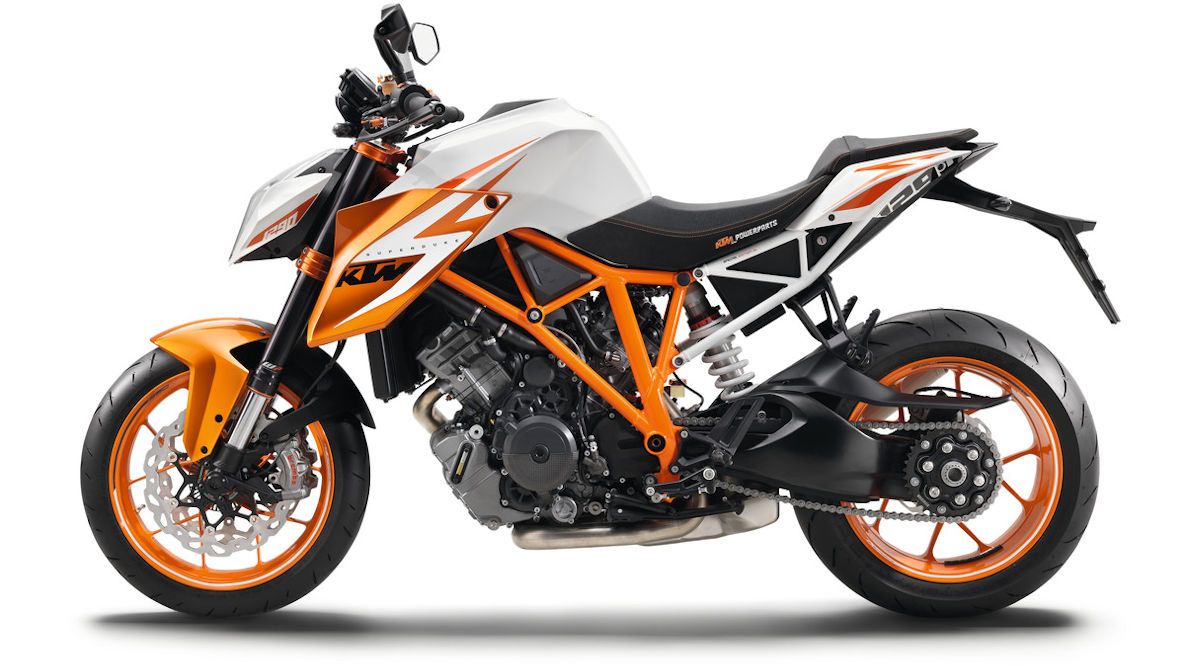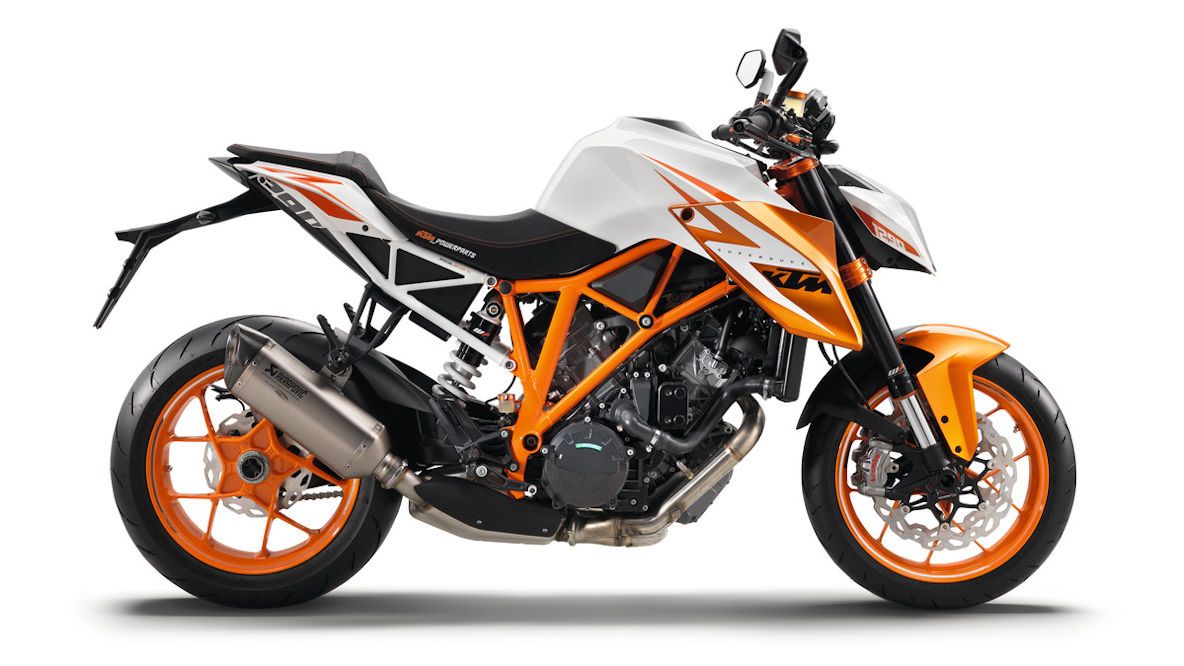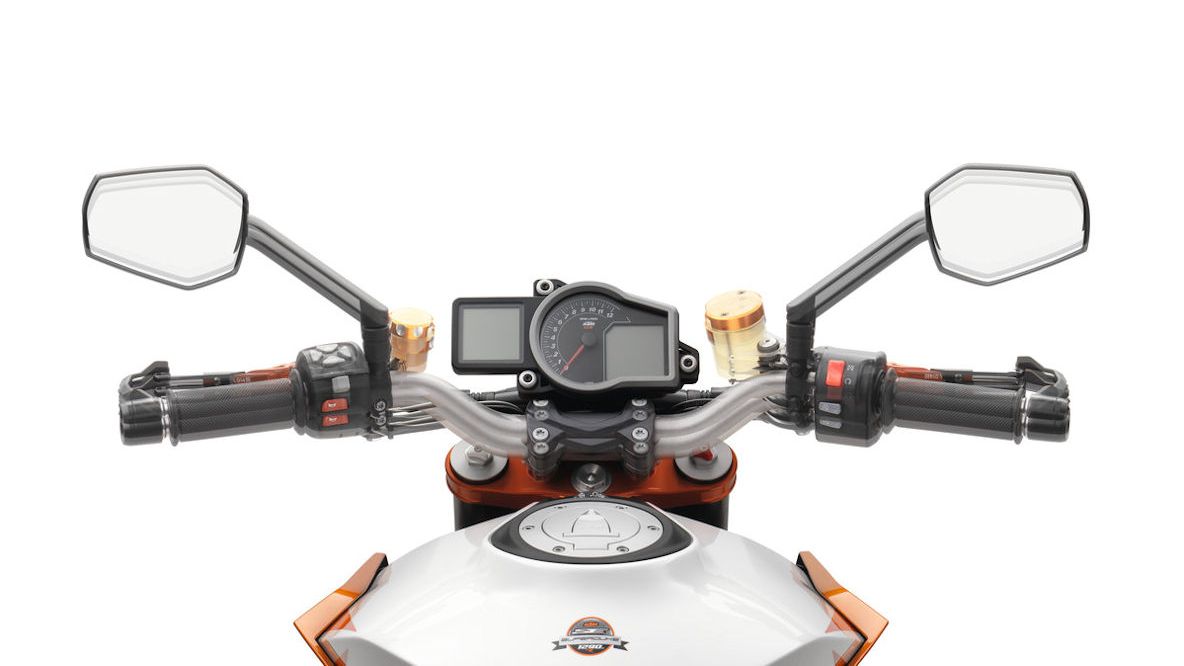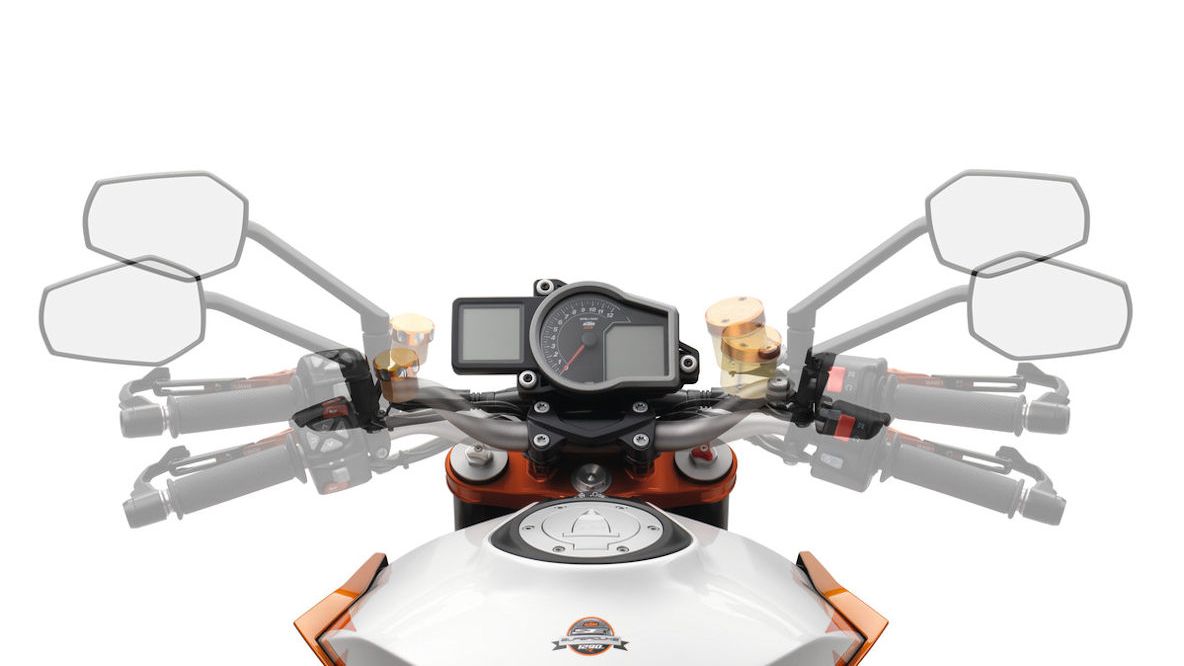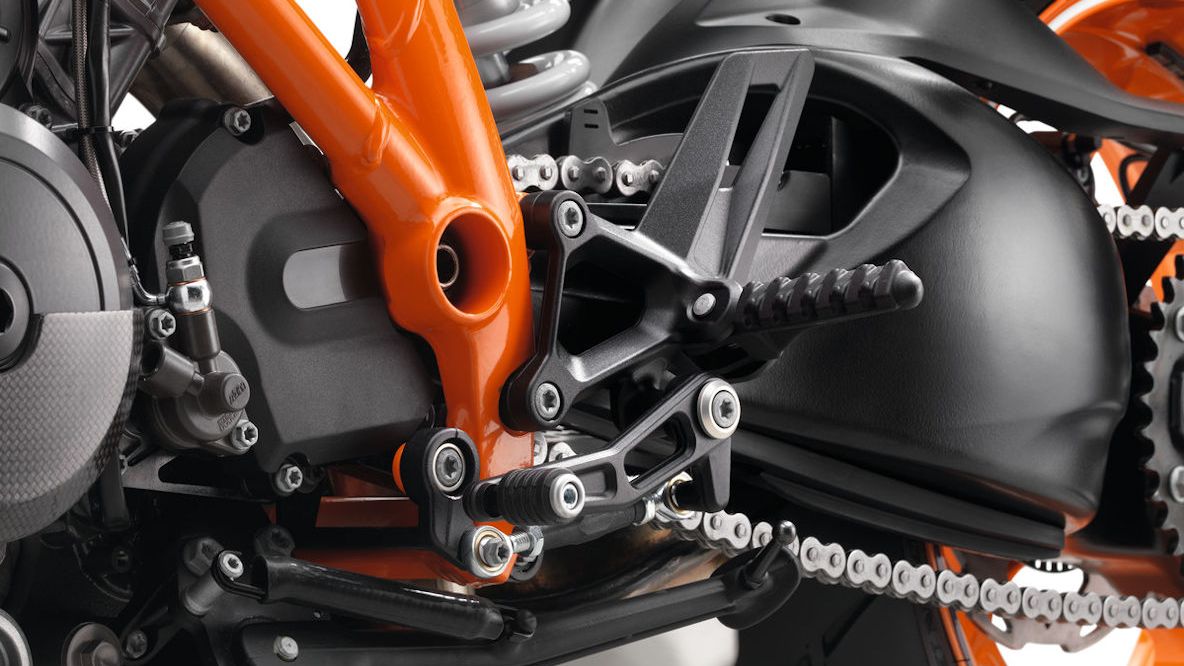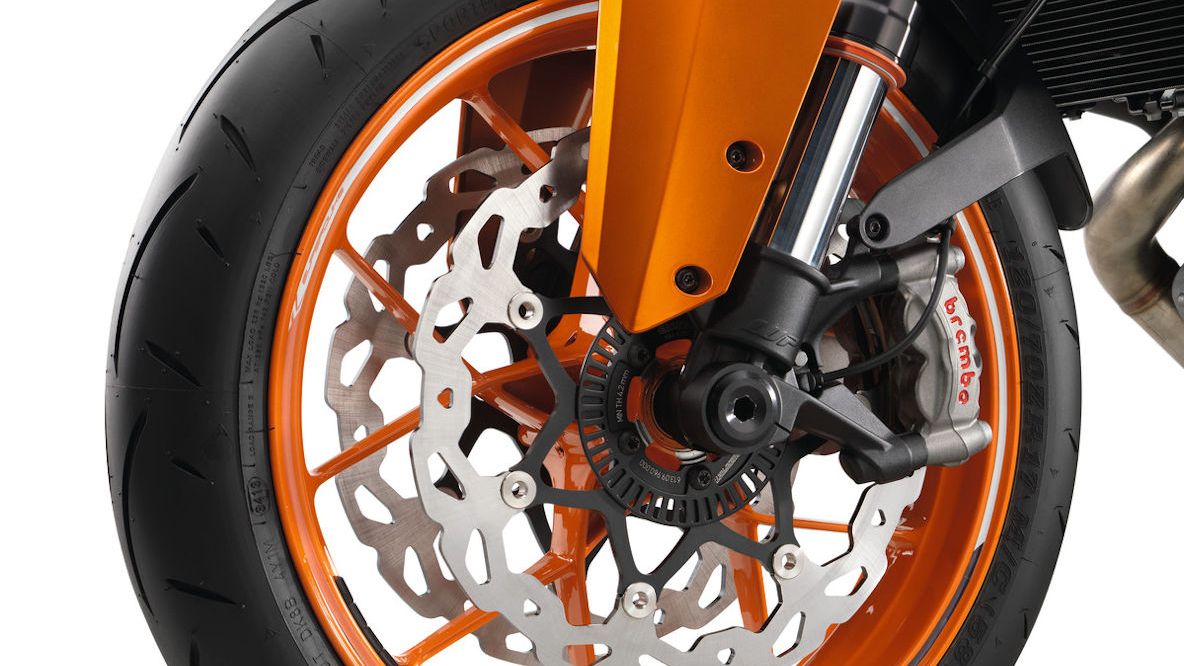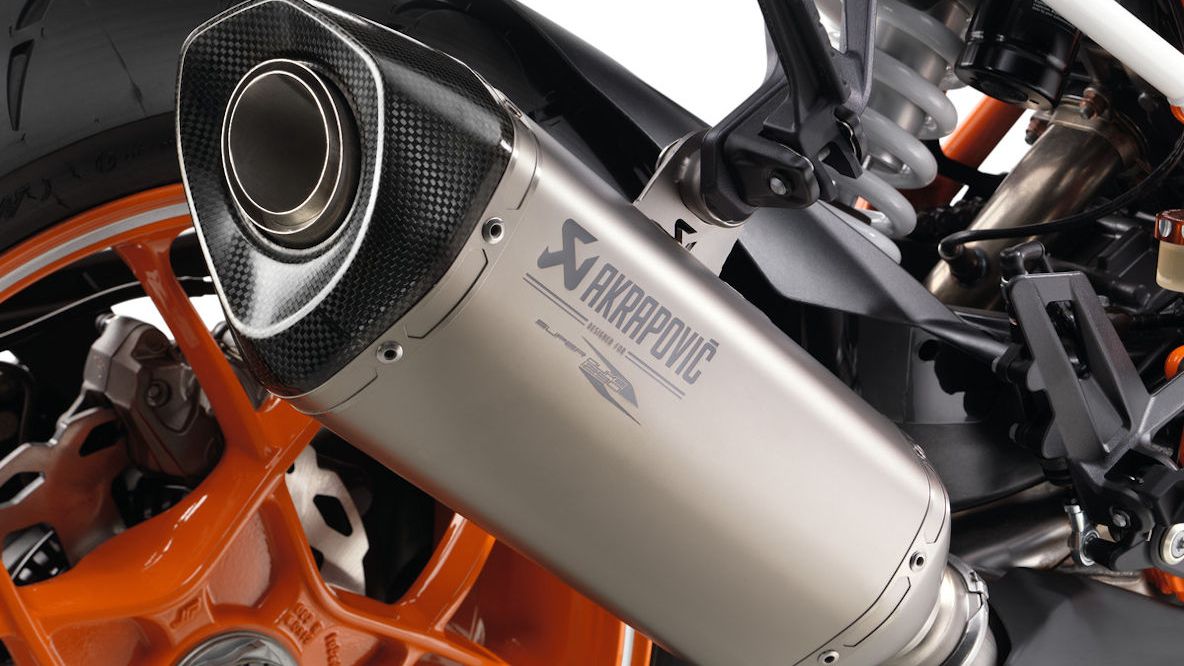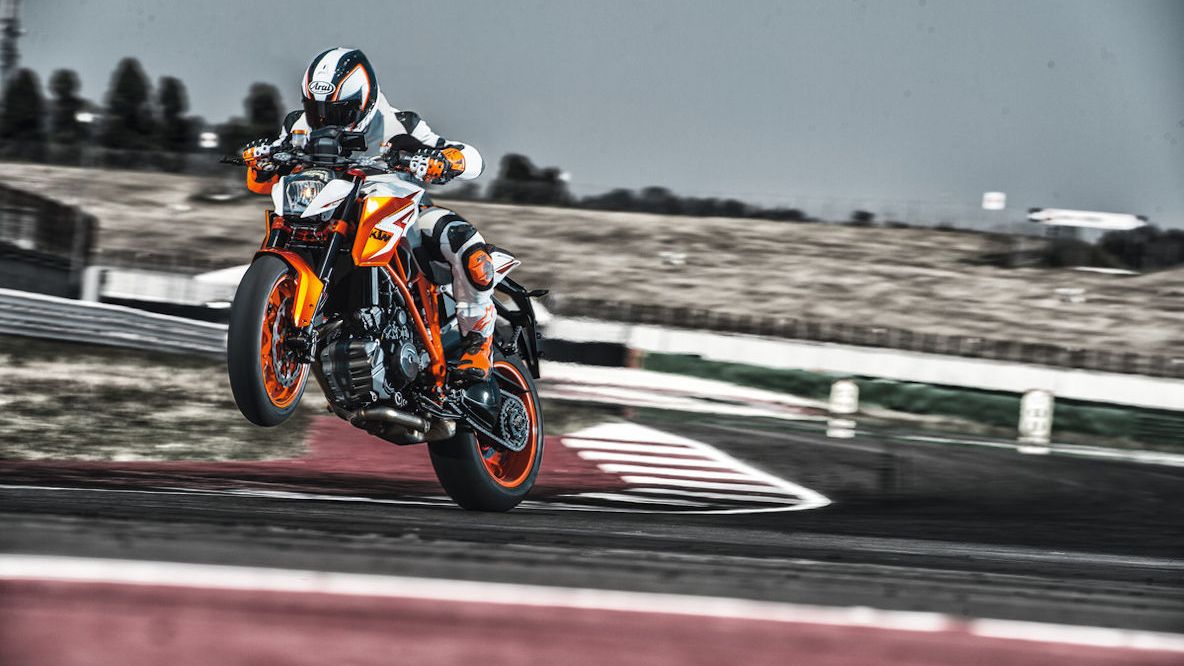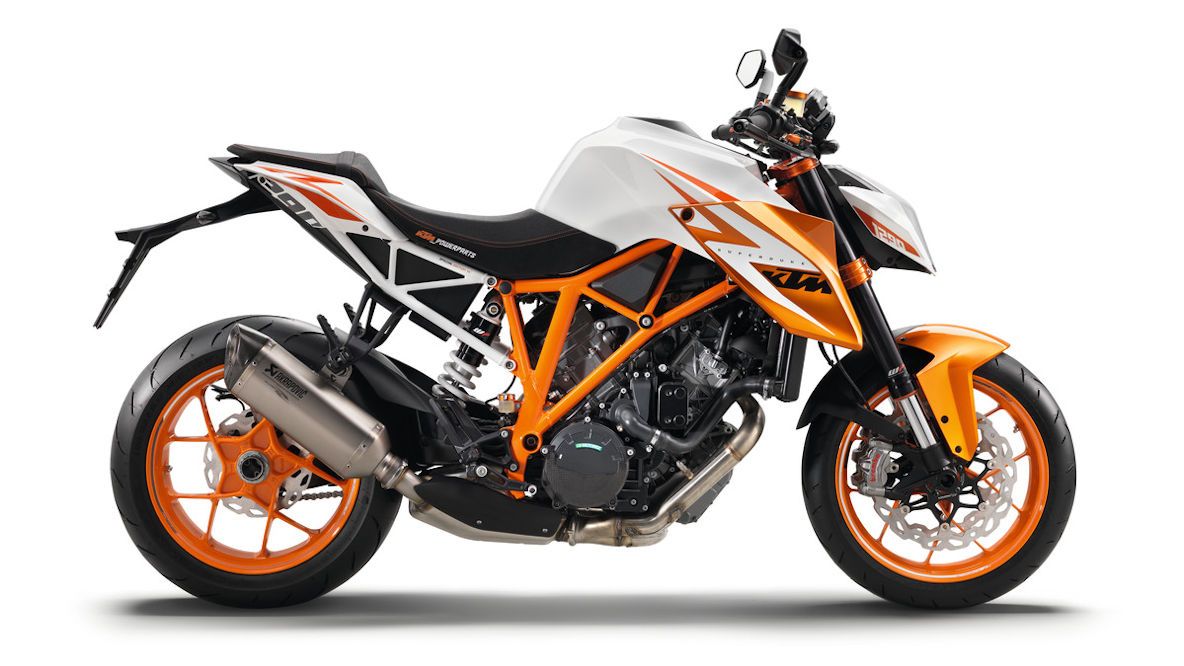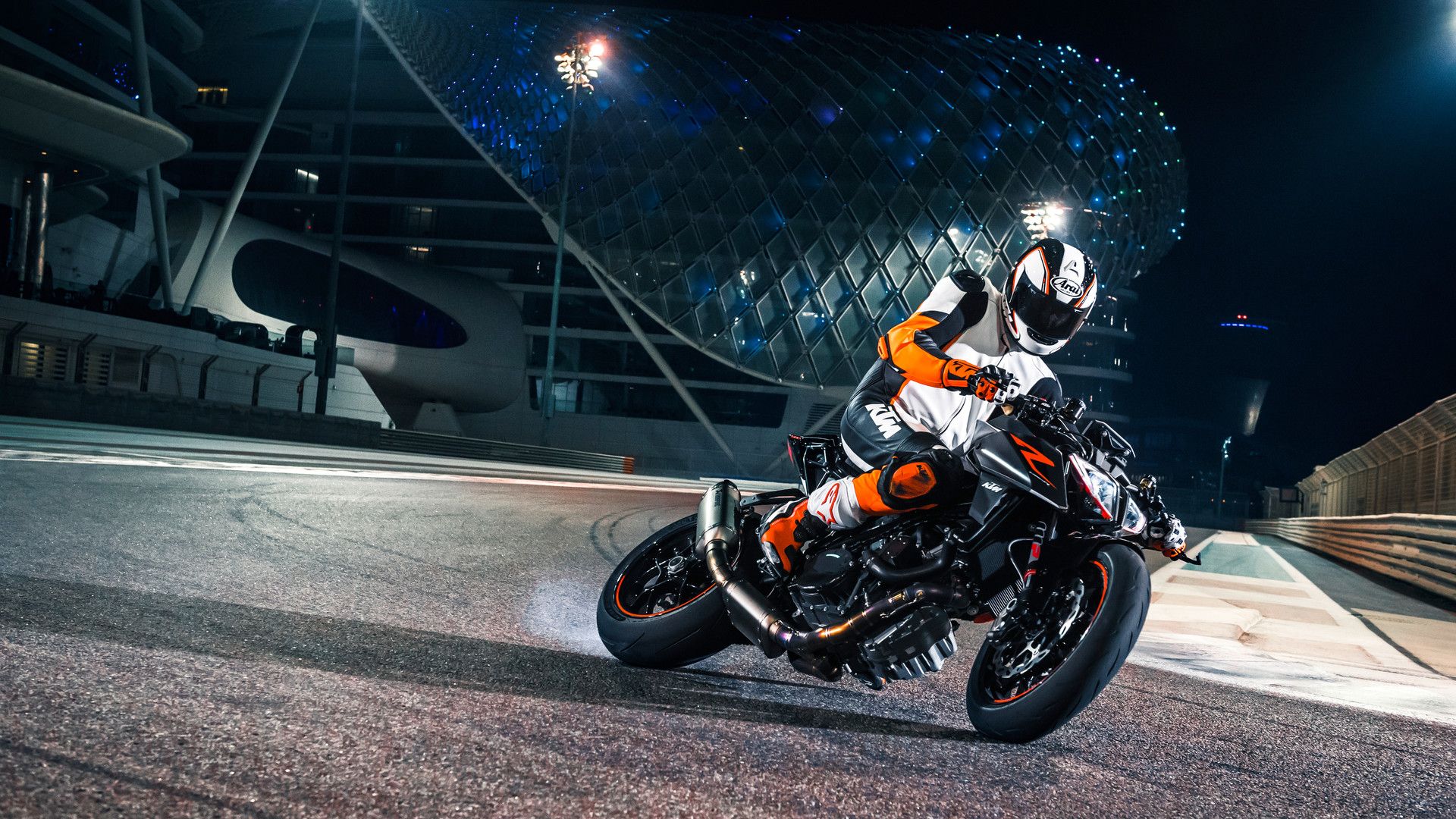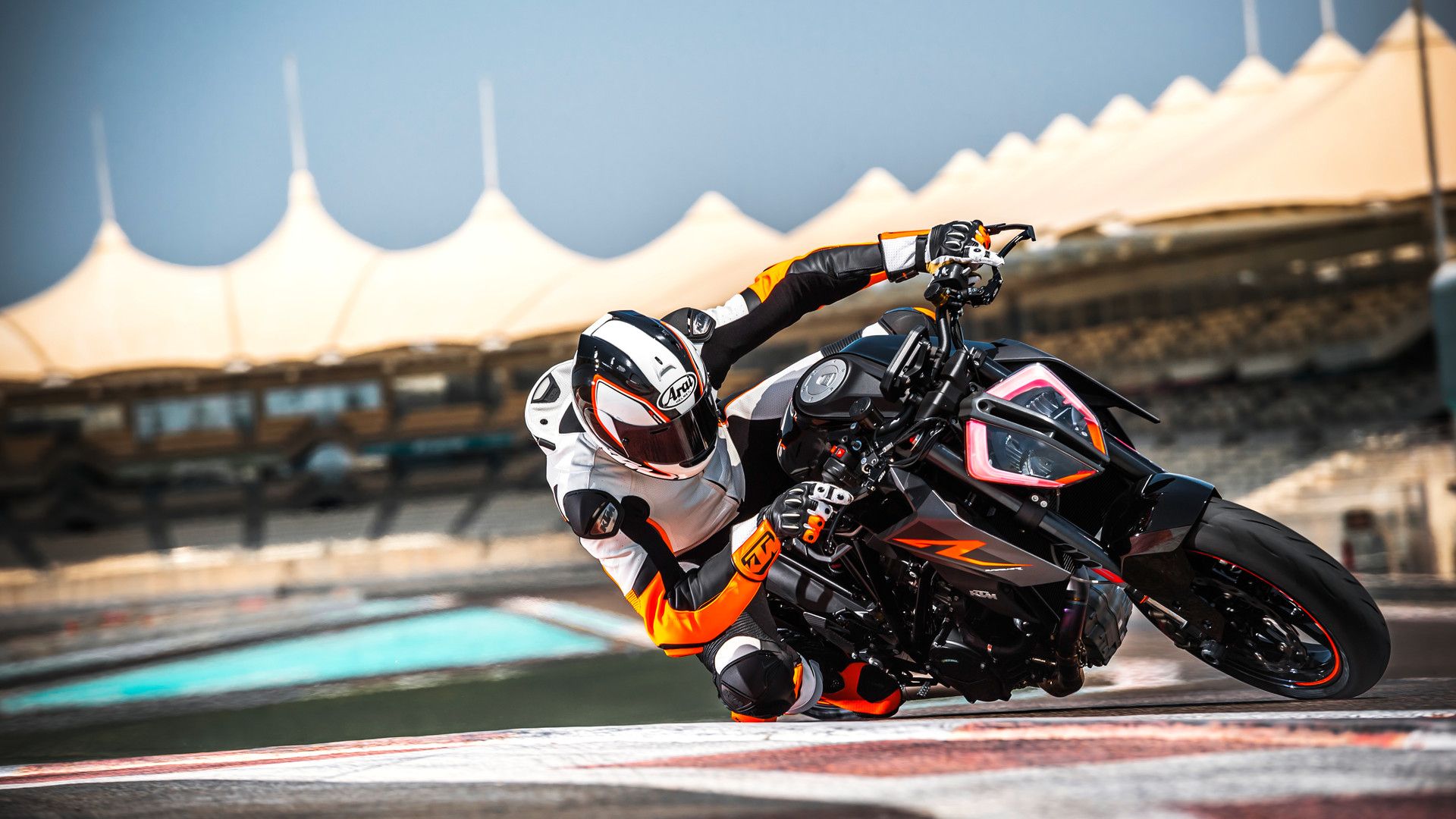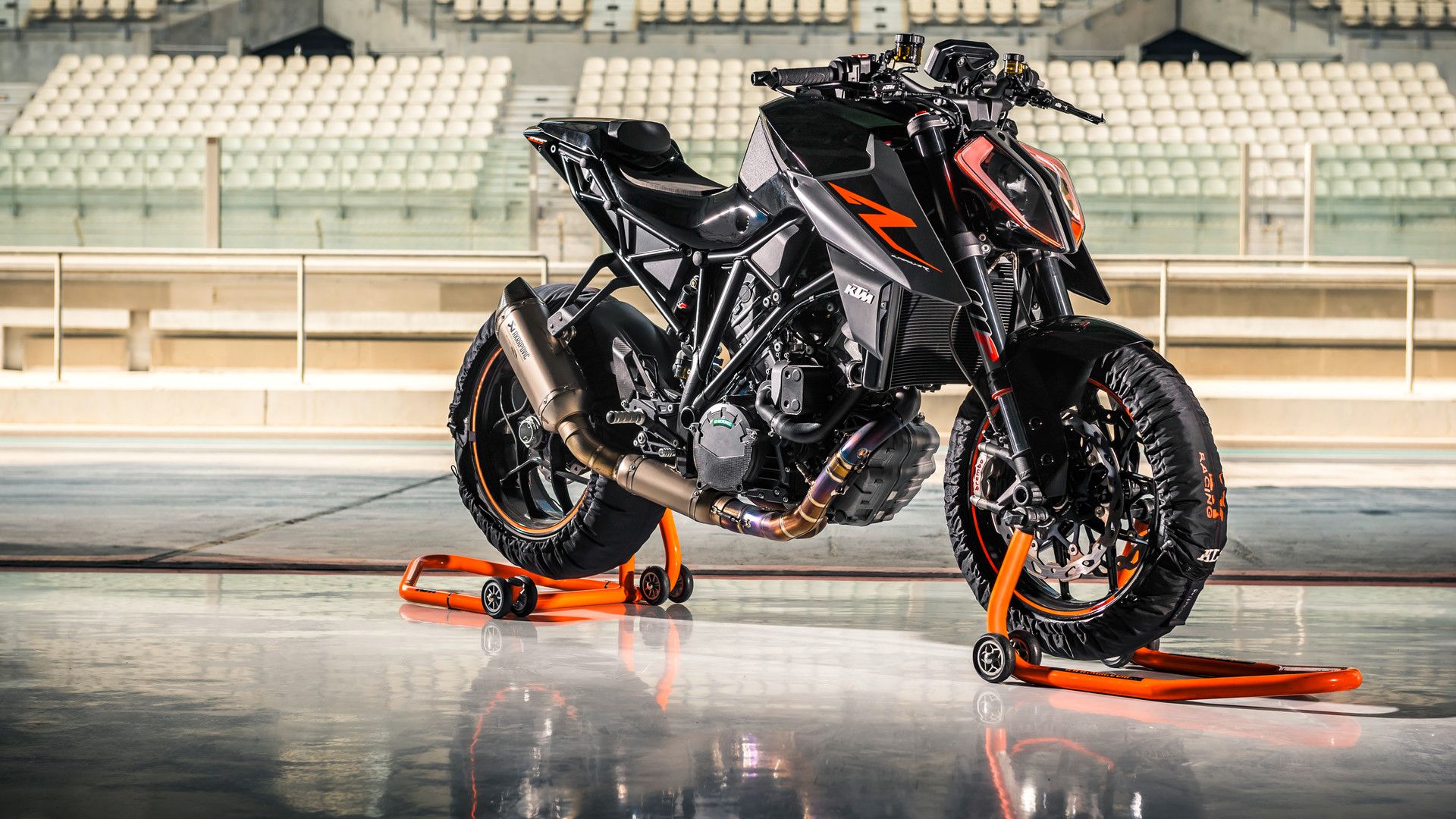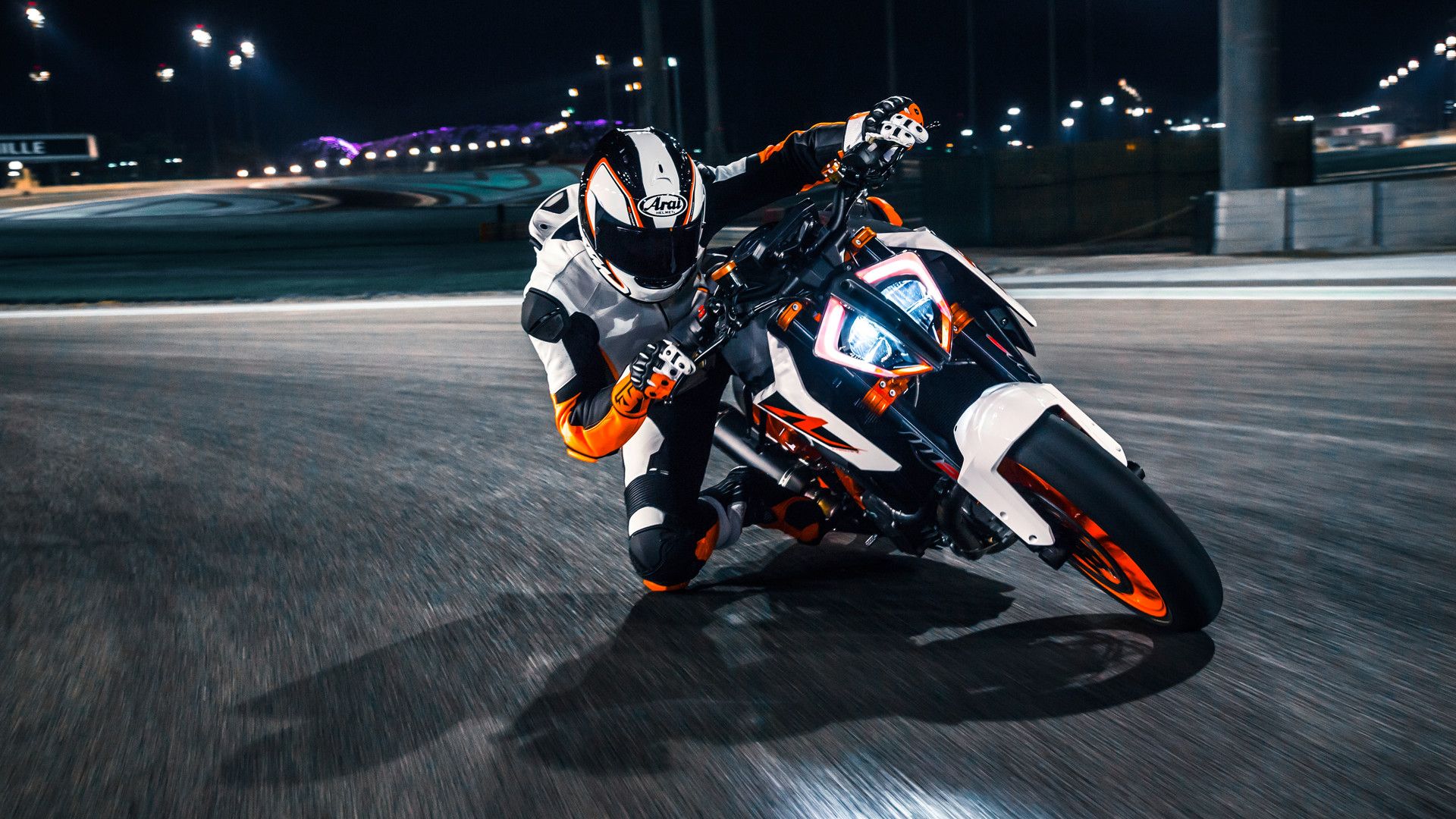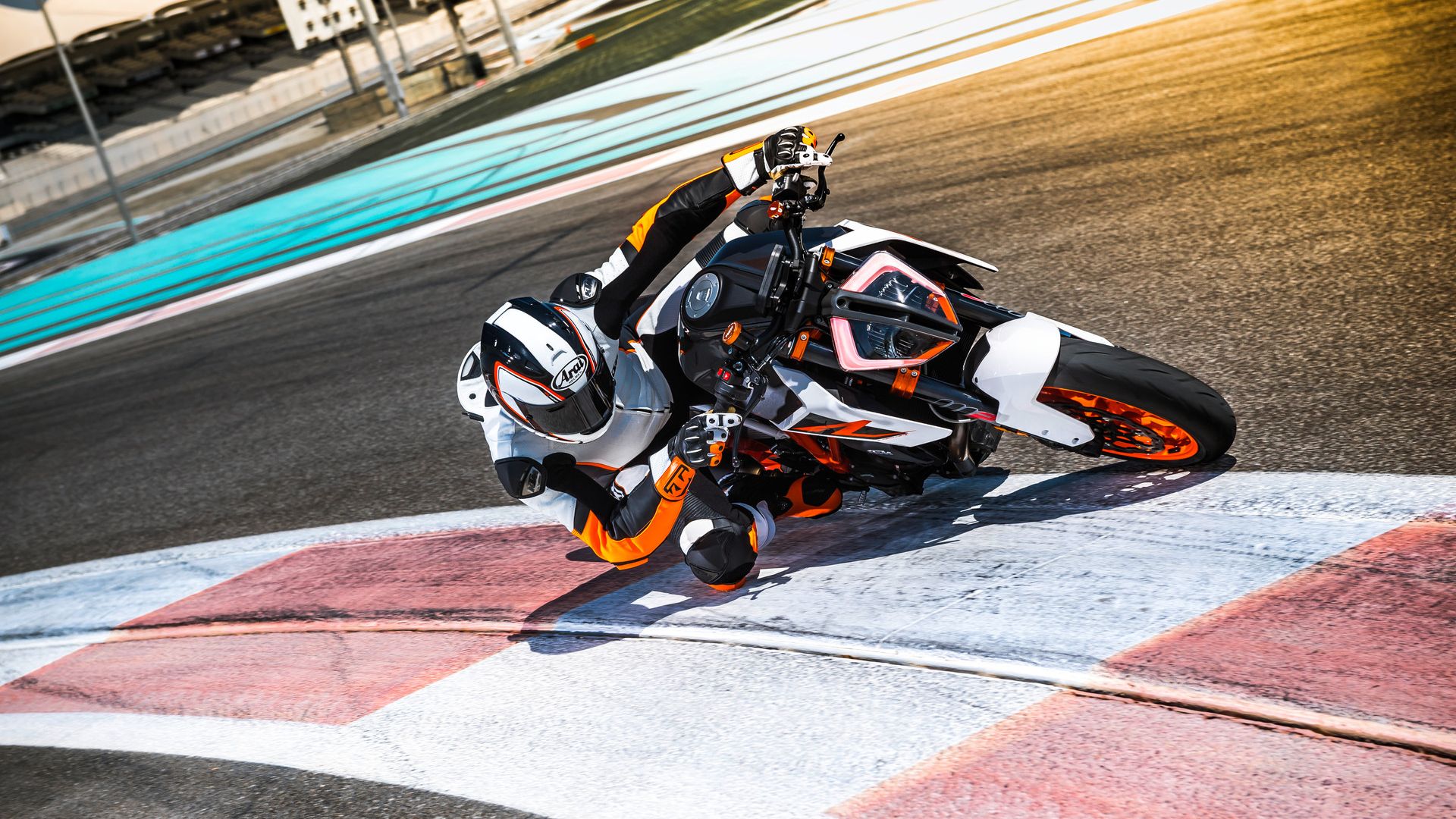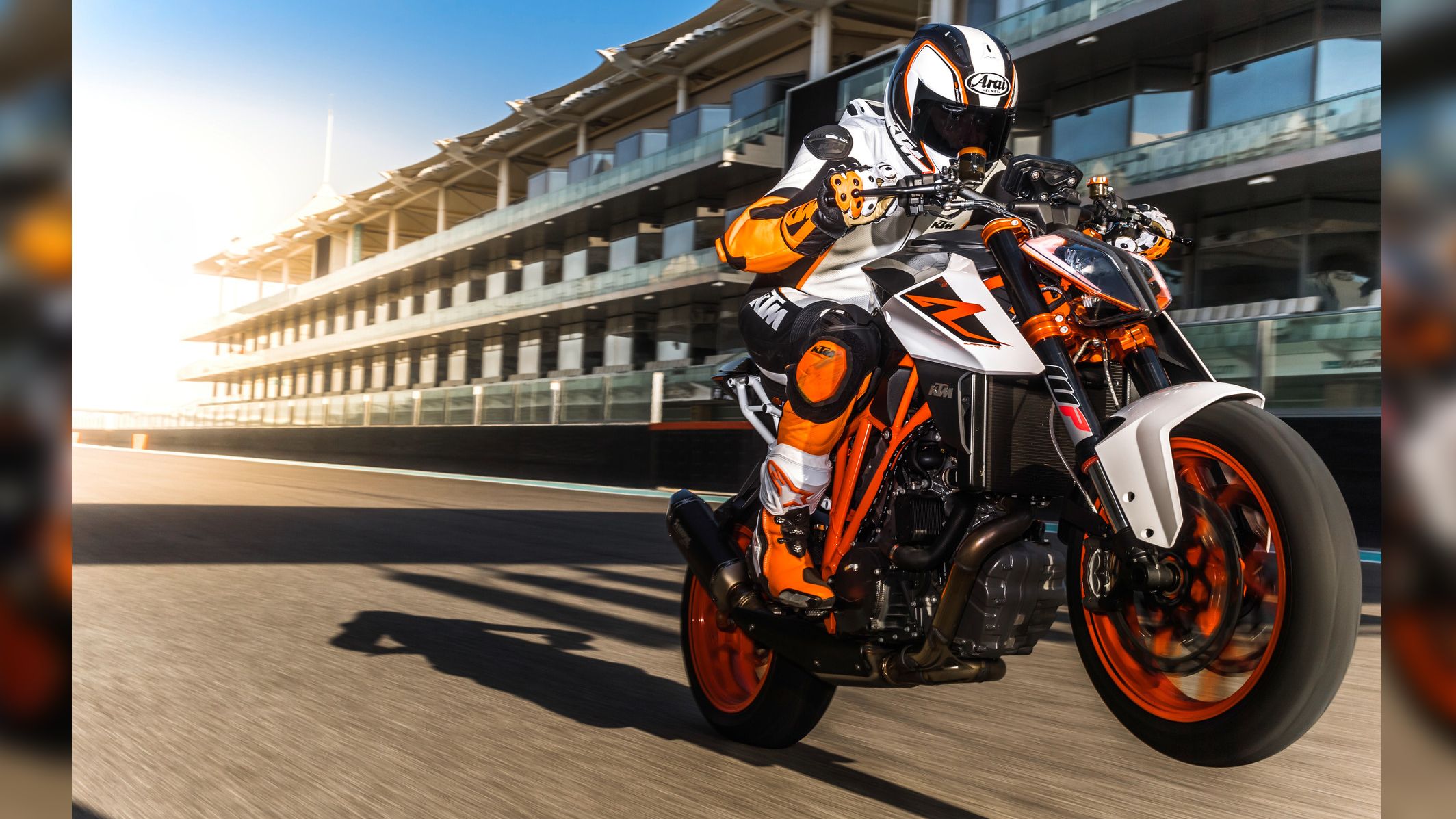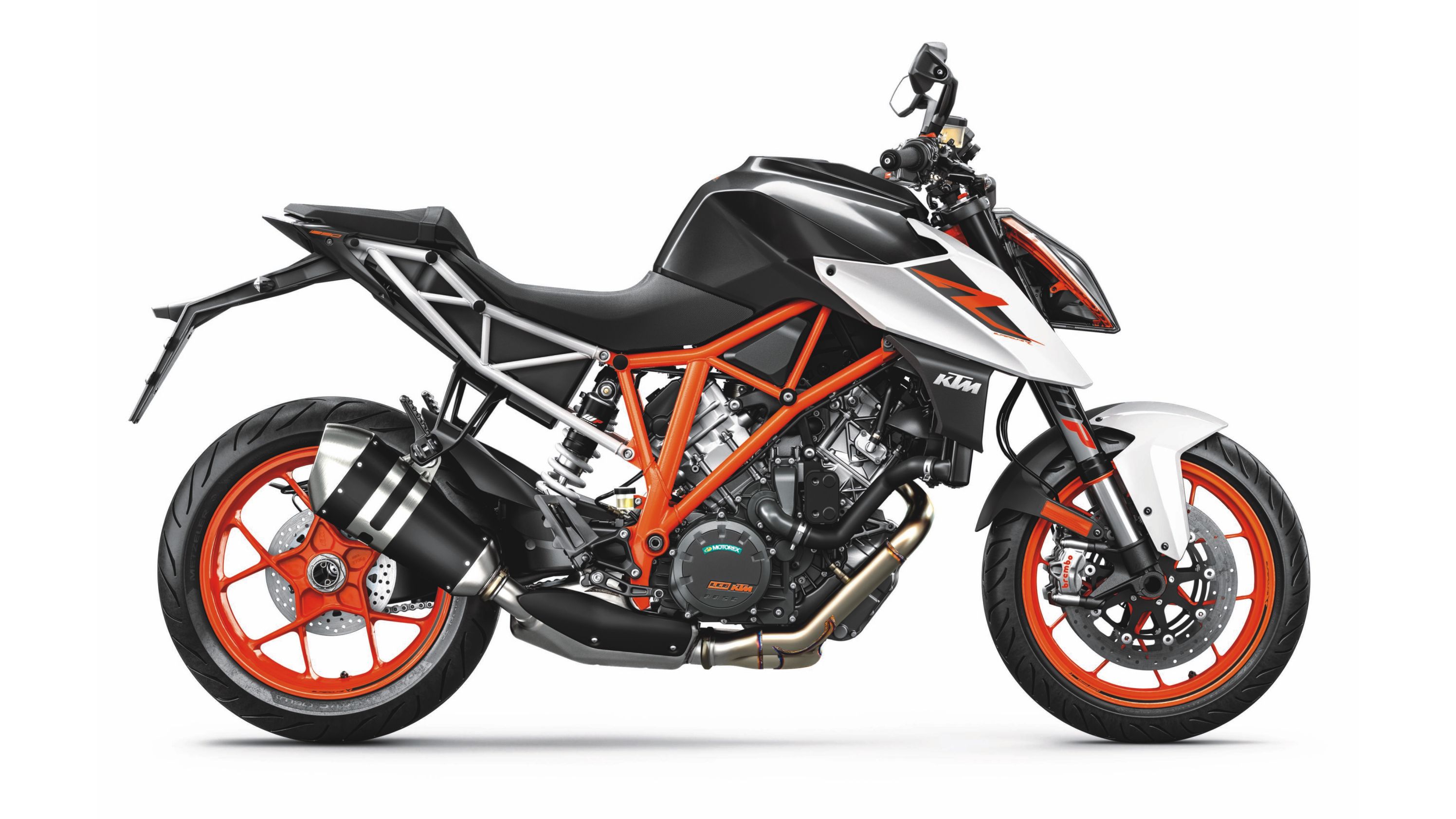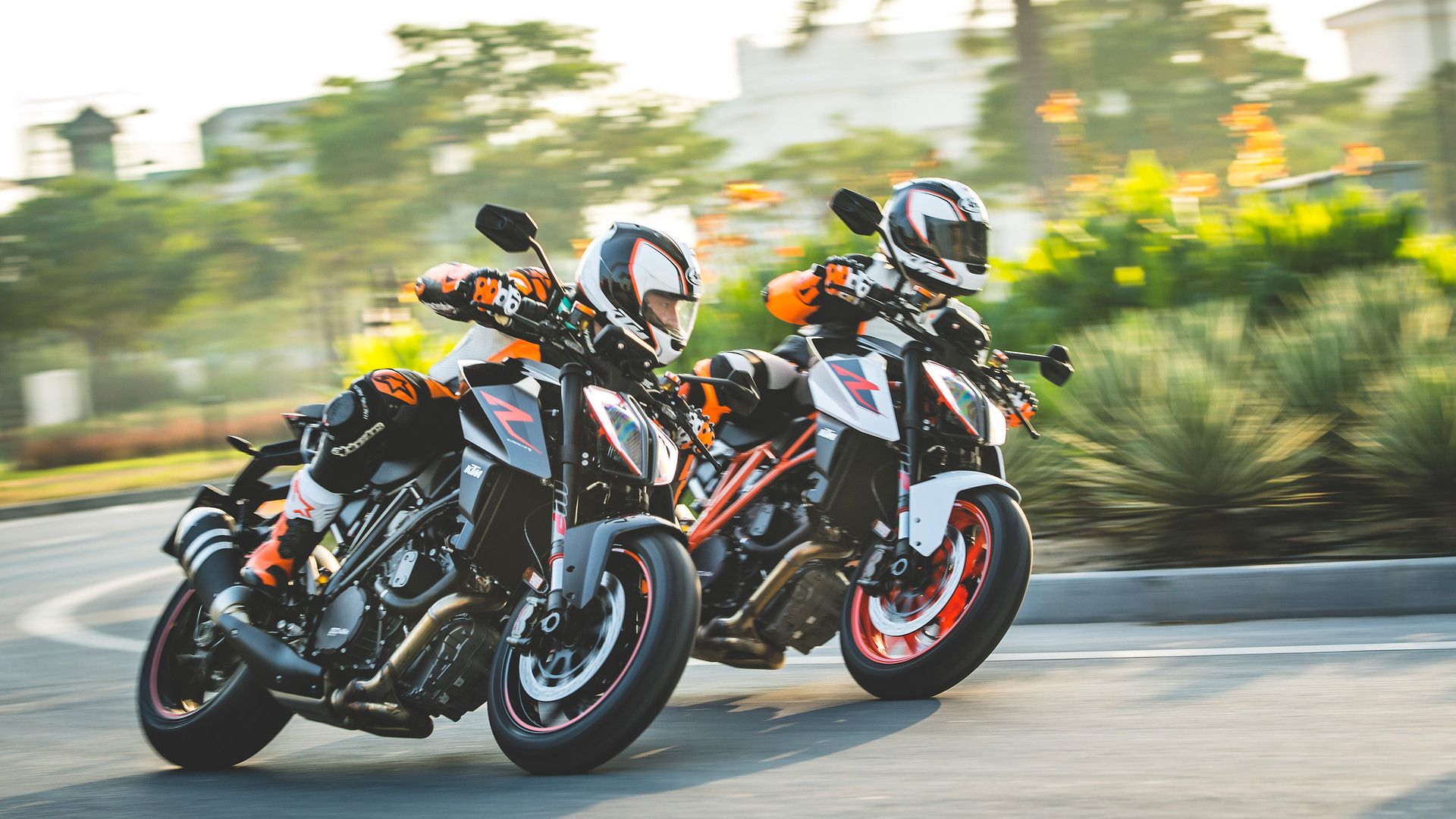KTM has long been famous for building competitive offroad/dirtbike machines, and the Duke line actually started off as such. With each successive Duke model, the factory has moved further away from its dirt roots and into the domain of street bikes. The 1290 Super Duke R represents the pinnacle (so far...) of KTM's naked bike streetfighter development, and it proves that the factory has fully grasped what it takes to build a truly competitive street machine with the cutting-edge design features demanded by today's sportbike riders.
Continue reading for my full review of the KTM 1290 Super Duke R.
2015 - 2016 KTM 1290 SUPER DUKE R ABS
- Make: Array
- Model: 2015 - 2016 KTM 1290 SUPER DUKE R ABS
- Engine/Motor: 2-cylinder, 4-stroke, spark-ignition engine, 75° V arrangement, liquid-cooled
Design
Much like the smaller Duke models, this ride is built to be the epitome of bare-bike design. Minimal body paneling leaves you with an unimpeded view of the frame, engine and running gear, and it makes the bike look lean as a snake, leaving nothing to the imagination. Even the swingarm and rear monoshock are plainly visible, which is unusual even among naked bikes.
Nothing between the Transformer-looking headlight housing and the afterthought-class rear mudguard seems to have distracted the designers from their purpose, and the specs and performance shows that they spent their energies on less apparent, but more important, systems and features. One notable exception is the rider saddle and pillion pad. Riders of previous Duke models mention a less-than-comfortable seat (“made of concrete” was the language that one rider used), but this seat is relatively comfortable, by comparison at least.
In addition to all the features on the base-model, the Super Duke R Special Edition comes with a special, orange and white paint job, and some performance components from KTM's PowerParts selection. This includes a titanium, Akrapovic exhaust, special engine covers, wave-cut brake discs, clamp-on, adjustable handlebars and a special seat -- all meant to make for a more race-tastic ride right off the showroom floor.
Chassis
A chrome-molybdenum frame and aluminum subframe form the backbone to provide the necessary rigidity to handle the stresses of aggressive cornering and maneuvers, and a hydraulic steering damper helps to reduce handlebar kickback when you hit a rough patch in the road.
On the subject of rough patches, the WP inverted front forks are independently adjustable for compression damping and rebound, so you can dial the bike in to your specific riding style or road conditions quickly and easily; same thing with the WP monoshock on the lightweight, single-sided swingarm. High-speed and low-speed compression damping and rebound can be separately tweaked at the remote shock reservoir, and the spring preload can be hand adjusted, eliminating the need to carry a shock spanner.
The Bosch 9M+ twin-channel ABS works to prevent loss of traction with varying degrees of intervention, depending on which setting you use out of the Sport, Street, Rain or Supermoto choices. If you really know what you are doing and/or want to hit the track, you can even turn it off for full manual brake function. This system works with the all-around, four-piston Brembo calipers, with dual brakes up front on 320 mm discs and a single 240 mm disc in the back.
No matter how complicated the traction control systems are, you need good rubber under you for it to make any difference. KTM makes certain that the tires are up to the job by using the Dunlop Sportsmart tubeless tires designed for even wear and outstanding steering performance and grip.
Drivetrain
If the chassis is the setting, then the LC8 engine is definitely the crown jewel. The 1,301 cc, four-stroke, liquid cooled 75-degree V-twin engine cranks out a whopping 106.2 pound-feet of torque and 177 horsepower with lightweight, forged pistons that reduce reciprocating mass to allow for faster response to changes in throttle settings. Furthermore, the piston skirts have a hard, anodized coating that reduces piston-to-cylinder friction and wear.
The heads contain two spark plugs per cylinder, with an electronic twin-ignition system that uses independent fire mapping to further increase combustion and torque while reducing emissions. A catalyst within the presilencer catches and burns any free hydrocarbons that manage to escape the combustion chamber to complete the emission controls for the engine.
Twin-valve, 56 mm throttle bodies by Keihin manage the air-fuel induction under the watchful eye of the Motorcycle Traction Control (MTC) system. The system monitors wheel-speed differential and lean angle, and intervenes as necessary to preserve contact-patch integrity based on the selected Rider Mode, much like the ABS does. What this means to you is that you can get as twisty as you want with the throttle (depending on setting) without fear of pushing the safety envelope, at least as far as traction goes.
Even though these systems act as a guardian angel of sorts, I would warn against relying too heavily on them and throwing caution to the wind – all the traction in the world won't save you if you can't keep it between the paint!
Price
Both the '15 and '16 base-model Duke Rs rolled for $17,399 MSRP in the U.S. Predictably, the Special Edition was a bit prouder with a $19,499 price tag, but anything with the word “special” anywhere in its name is automatically worth more, right? Seriously though, KTM does pack on some “fun bits” to cover the difference, and it's more than just a cute paint job and a few fancy baubles. For 2017, the price is bumped just a few bills, but still within range.
Competitor
Naked streetfighters in the 1200 cc range are not hard to come by, and though there are plenty in the Asian market, I decided to see how the Super Duke compared against a product from another European manufacturer. Since my default favorite in that neck of the woods is Ducati, the Monster 1200 seemed the logical choice.
In spite of the fact that the Super Duke 1290 is a straight-up streetbike, the dirt-bike DNA still kind of shines through in the tank design, headlight housing and cheek fairings. Not saying that it's a bad thing, just saying that it is. The Ducati Monster carries more of what you might call rounded, almost feminine curves for a graceful note in its overtly aggressive panache. Not calling it a girl's bike, just saying it has some voluptuous curvulation (sic) going on over there. Both of them carry their Trellis frames proudly exposed, a necessary element for a “naked” bike, and one that adds a bit of Mad Max to the mix.
Gadgetry is likewise similar between the two. They both sport nine-channel ABS, ride-by-wire throttles, rider modes and configurable traction control -- all good stuff, and to be expected on bikes like this nowadays. KTM takes it just a step further with a lean-angle sensor that dynamically tunes the traction control as you corner, and this little nugget represents the only notable difference between the electronics suites.
Now for the powerplants. Ducati runs its 1,198 cc Testastretta Desmodromic engine, and its not too shabby with 87 pounds of grunt and 135 ponies. Unfortunately Ducati get hosed at the dyno this time 'cause the Super Duke cranks out 106.2 pound-feet and 177 ponies for a difference you will definitely feel below the belt.
This extra power with the KTM comes with a heavy price; almost $18 grand, significantly higher than the $13,995 sticker on the Monster. For my money, not only is the Duc cheaper, but it's better looking as well, and I'd probably never be able to drive either to its full potential, so missing out on all that KTM yummy-goodness is no big deal to me.
He Said:
“Where to start? I thought the Duke 690 was a heck of a bike, but this thing is a beast with a capital B! As much as I do not trust RbW, and think that the traction control and throttle intervention are crutches best avoided lest you become dependent on them, I think that I would avail myself of their services on this ride. In fact, I implore KTM to add a “Wimp” mode to allow guys like me to ease into our relationship with this ride, because I can definitely see the potential for getting in over my head – quick, fast and in a hurry!”
She Said
My wife and fellow writer, Allyn Hinton, says, "This bike has been called the most extreme Super Duke ever, and I can see why. With impressive performance data and aggressive styling, this ride is fierce and fearless. I like the slipper clutch system that works with engine torque allowing for the use of softer clutch springs, the result being a clutch lever that you can pull without Popeye forearms. I also note the way the rider's knees tuck under the body panels out of the slipstream when he's in that 'racing' posture. This ride looks fearless and aggressive even when standing still."
Specifications
|
Engine: |
|
|
Type: |
Two-Cylinder, Four-Stroke, Spark-Ignition Engine, 75-Degree V-Twin, Liquid Cooled |
|
Displacement: |
1,301 cc |
|
Bore: |
108 mm |
|
Stroke: |
71 mm |
|
Starting Aid: |
Electric Starter |
|
Performance: |
177 Horsepower |
|
Engine Lubrication: |
Forced Oil Lubrication With Three Rotor Pumps |
|
Primary Gear Ratio: |
40:79 |
|
Secondary Gear Ratio: |
17:38 |
|
Cooling System: |
Liquid Cooling System, Continuous Circulation Of Cooling Liquid With Water Pump |
|
Clutch: |
PASC™ Anti-Hopping Clutch/ Hydraulically Operated |
|
Ignition System: |
Contactless, Controlled, Fully Electronic Ignition System With Digital Ignition Timing Adjustment |
|
Chassis: |
|
|
Frame: |
Tubular Space Frame Made From Chrome Molybdenum Steel, Powder-Coated |
|
Fork: |
WP Suspension Up Side Down |
|
Shock Absorber: |
WP Suspension Monoshock |
|
Suspension Travel Front: |
4.9 Inches |
|
Suspension Travel Rear: |
6.1 Inches |
|
Brake System Front: |
Twin-Disc Brake With Radially Mounted Four-Piston Brake Calipers |
|
Brake System Rear: |
Single-Disc Brake With Two-Piston Brake Caliper; Fixed Brake Disc |
|
Brake Discs - Diameter Front: |
320 mm |
|
Brake Discs - Diameter Rear: |
240 mm |
|
Chain: |
5/8 X 5/16 Inches X‑Ring |
|
Dimensions: |
|
|
Steering Head Angle: |
65.1 Degrees |
|
Wheel Base: |
58.3 inches ± 0.6 inches |
|
Ground Clearance (Unloaded): |
5.5 Inches |
|
Seat Height (Unloaded): |
32.9 Inches |
|
Details: |
|
|
Total Fuel Tank Capacity Approx.: |
4.8 Gallons Unleaded Premium Fuel (95 RON) |
|
Weight Without Fuel Approx.: |
416.7 Pounds |
References
See our review of the Ducati Monster 1200


